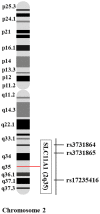Association of SLC11A1 polymorphisms with anthropometric and biochemical parameters describing Type 2 Diabetes Mellitus
- PMID: 37062790
- PMCID: PMC10106459
- DOI: 10.1038/s41598-023-33239-3
Association of SLC11A1 polymorphisms with anthropometric and biochemical parameters describing Type 2 Diabetes Mellitus
Abstract
Diabetes, a leading cause of death globally, has different types, with Type 2 Diabetes Mellitus (T2DM) being the most prevalent one. It has been established that variations in the SLC11A1 gene impact risk of developing infectious, inflammatory, and endocrine disorders. This study is aimed to investigate the association between the SLC11A1 gene polymorphisms (rs3731864 G/A, rs3731865 C/G, and rs17235416 + TGTG/- TGTG) and anthropometric and biochemical parameters describing T2DM. Eight hundred participants (400 in each case and control group) were genotyped using the polymerase chain reaction-restriction fragment length polymorphism (PCR-RFLP) and amplification-refractory mutation system-PCR (ARMS-PCR) methods. Lipid profile, fasting blood sugar (FBS), hemoglobin A1c level, and anthropometric indices were also recorded for each subject. Findings revealed that SLC11A1-rs3731864 G/A, -rs17235416 (+ TGTG/- TGTG) were associated with T2DM susceptibility, providing protection against the disease. In contrast, SLC11A1-rs3731865 G/C conferred an increased risk of T2DM. We also noticed a significant association between SLC11A1-rs3731864 G/A and triglyceride levels in patients with T2DM. In silico evaluations demonstrated that the SLC11A2 and ATP7A proteins also interact directly with the SLC11A1 protein in Homo sapiens. In addition, allelic substitutions for both intronic variants disrupt or create binding sites for splicing factors and serve a functional effect. Overall, our findings highlighted the role of SLC11A1 gene variations might have positive (rs3731865 G/C) or negative (rs3731864 G/A and rs17235416 + TGTG/- TGTG) associations with a predisposition to T2DM.
© 2023. The Author(s).
Conflict of interest statement
The authors declare no competing interests.
Figures





Similar articles
-
SLC11A1 polymorphisms and host susceptibility to cutaneous leishmaniasis in Pakistan.Parasit Vectors. 2017 Jan 7;10(1):12. doi: 10.1186/s13071-016-1934-2. Parasit Vectors. 2017. PMID: 28061874 Free PMC article.
-
Association of SLC11A1 with tuberculosis and interactions with NOS2A and TLR2 in African-Americans and Caucasians.Int J Tuberc Lung Dis. 2009 Sep;13(9):1068-76. Int J Tuberc Lung Dis. 2009. PMID: 19723394 Free PMC article.
-
Evidence of association with type 1 diabetes in the SLC11A1 gene region.BMC Med Genet. 2011 Apr 27;12:59. doi: 10.1186/1471-2350-12-59. BMC Med Genet. 2011. PMID: 21524304 Free PMC article.
-
Susceptibility to leishmaniasis is affected by host SLC11A1 gene polymorphisms: a systematic review and meta-analysis.Parasitol Res. 2019 Aug;118(8):2329-2342. doi: 10.1007/s00436-019-06374-y. Epub 2019 Jun 23. Parasitol Res. 2019. PMID: 31230160
-
Genetic variants of SLC11A1 are associated with both autoimmune and infectious diseases: systematic review and meta-analysis.Genes Immun. 2015 Jun;16(4):275-83. doi: 10.1038/gene.2015.8. Epub 2015 Apr 9. Genes Immun. 2015. PMID: 25856512
Cited by
-
IGF2BP2 and IGFBP3 Genotypes, Haplotypes, and Genetic Models Studies in Polycystic Ovary Syndrome.J Clin Lab Anal. 2024 Mar;38(5):e25021. doi: 10.1002/jcla.25021. Epub 2024 Mar 11. J Clin Lab Anal. 2024. PMID: 38468402 Free PMC article.
-
Preliminary insight into the potential role of Leptin Receptor Polymorphisms in Type 2 Diabetes Risk: case-control study and bioinformatics analysis.J Diabetes Metab Disord. 2025 May 3;24(1):113. doi: 10.1007/s40200-025-01617-5. eCollection 2025 Jun. J Diabetes Metab Disord. 2025. PMID: 40331155
-
Single nucleotide polymorphisms in the development of osteomyelitis and prosthetic joint infection: a narrative review.Front Immunol. 2024 Sep 5;15:1444469. doi: 10.3389/fimmu.2024.1444469. eCollection 2024. Front Immunol. 2024. PMID: 39301021 Free PMC article. Review.
-
Fitness landscapes of human microsatellites.PLoS Genet. 2024 Dec 30;20(12):e1011524. doi: 10.1371/journal.pgen.1011524. eCollection 2024 Dec. PLoS Genet. 2024. PMID: 39775235 Free PMC article.
-
The Link between Trace Metal Elements and Glucose Metabolism: Evidence from Zinc, Copper, Iron, and Manganese-Mediated Metabolic Regulation.Metabolites. 2023 Oct 2;13(10):1048. doi: 10.3390/metabo13101048. Metabolites. 2023. PMID: 37887373 Free PMC article. Review.
References
-
- International Diabetes Federation . IDF Diabetes Atlas. 9. International Diabetes Federation; 2023. - PubMed
Publication types
MeSH terms
Substances
LinkOut - more resources
Full Text Sources
Medical
Miscellaneous

